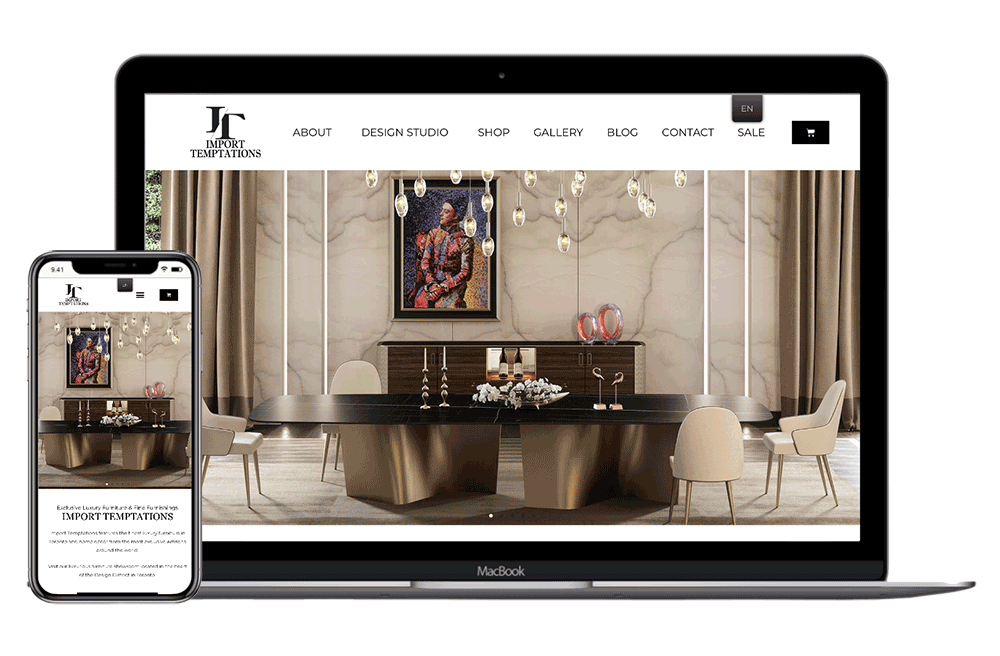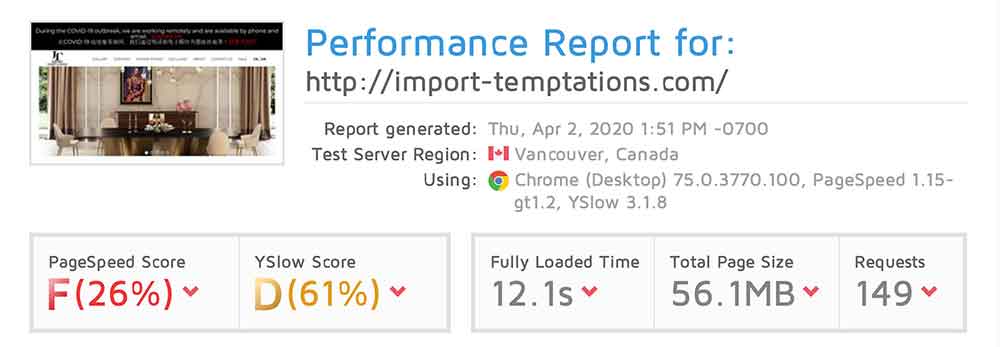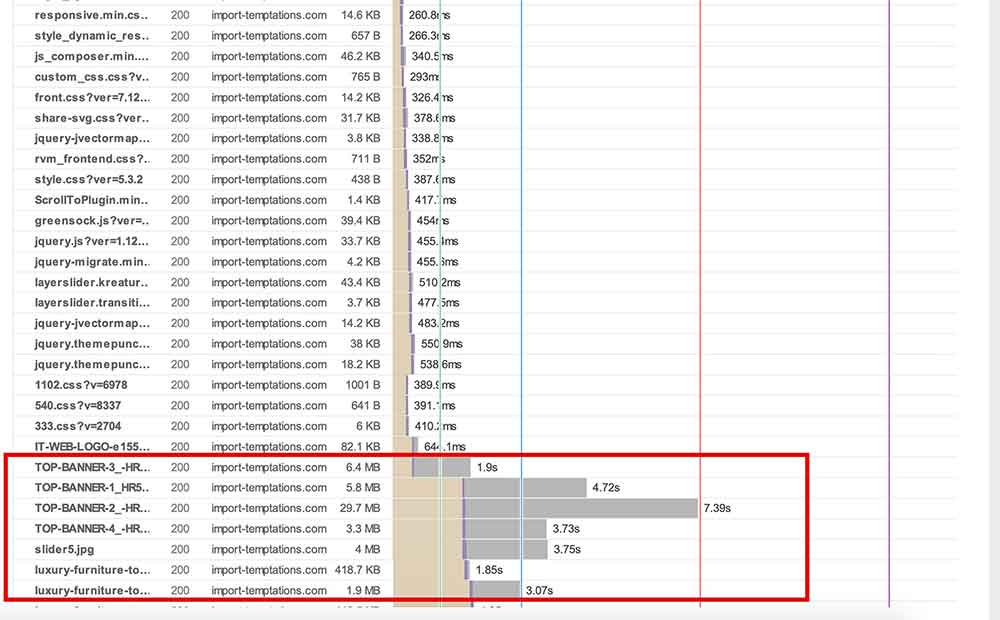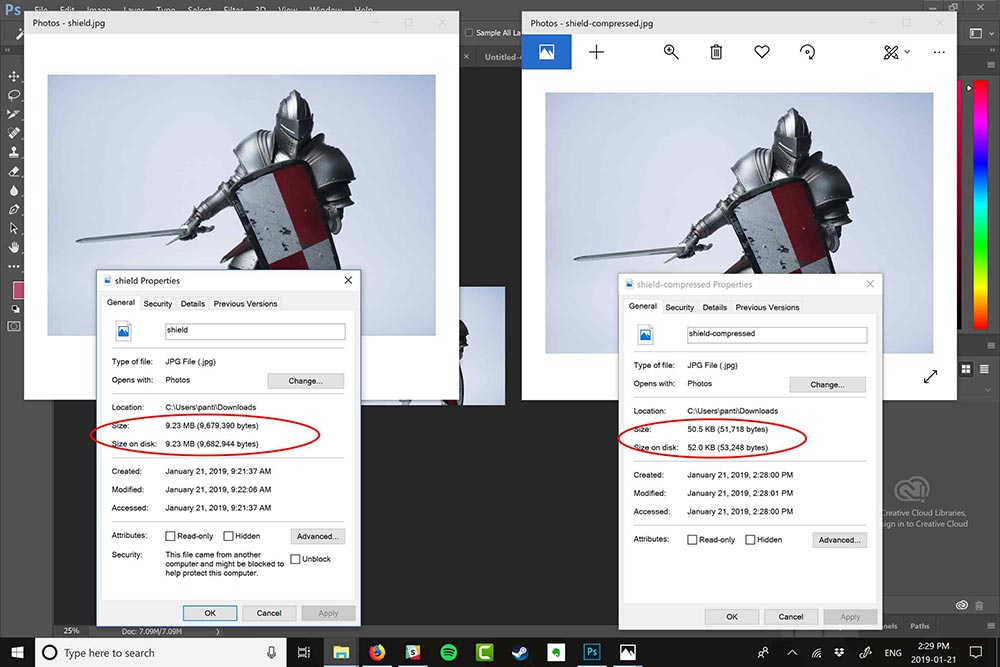Import Temptations
Rebuilding an expensive disaster into a affordable success
*The following is a true (horror) story of a website design gone wrong. It’s a case study that clearly articulates why so many businesses struggle to find a skilled, reliable and trustworthy web designer.
It contains failed processes, inflated value and deceptive practices. Viewer discretion is advised.*

Overview
Who, what, where, when and why.

Import Temptations is a luxury furniture store retailer located in Toronto, Canada.
To quote their website: “Family owned and operated since 1985, Import Temptations began its climb to success as a small wholesale company and growing quickly into an established and well-respected luxury furnishing and interior design business.
Joined by Lili Khalilnia’s husband, Frank Khalilnia, Import Temptation’s growth in the industry of furniture, giftware, and distinct design of mirrors, has gained the definitive image of being the very best in all aspects of consumer vision and fortifying strong relations.”
Their previous website was certainly functional. It adequately described most of their services and displayed their basic contact info.
But they recognized that it was time for something more.
The Challenge
They wanted a new website that:
Responsive
on any device.
Consistent
with their brand and values.
Integrated
with compelling blog content.
E-commerce store
to buy furniture directly online.
Prioritizes UX
and loads fast.
Easily manageable
by one of their staff.
The Problem
I have no idea what “Top Web Design Agency” promised, but it’s clear that they only delivered on a few of these:
- Is beautiful and responsive on any device ✅
- Consistent with their brand style and values ✅
Integrates compelling blog content❌Offers full e-commerce shopping functionality❌Prioritizes user experience and loads fast❌Can easily be maintained by one of their staff❌
Not delivering on #5 is the biggest failure here.
What’s the point of having a beautiful website that doesn’t even load?
The Process
Here’s the process I followed for this project:
Initial Consultation
Review of Website
Proposal
Website Rebuild
Launch
QA & Testing
The Story
Here’s how it all went down:
March. 2020.
An entire planet locks themselves indoors to hide from a virus taking the world by storm. Panic and fear reign supreme. Uncertainty is in the air.
I find myself in Mexico, obsessively checking the news, trying to figure out if I should abandon my 3-month trip to Spain that had only just begun. Thinking about what life in indefinite quarantine will look like.
But back home in Toronto, Canada, a luxury furniture company was experiencing their own type of crisis.
A few months before Covid-19, they had determined that they needed to redesign their website. Badly. Their current site was outdated and no longer meeting the needs of their customers. They had zero ability to sell their furniture online.
So, they hired one of the top web design agencies in Toronto to rebuild their website. For a cool $6,000.
In hindsight, the timing was perfect. They had zero clue that small businesses everywhere would soon be rushing to transition to an online-focused model. That they themselves would soon need to rely completely on selling their furniture online instead of in their store.
They had a head start. They would be prepared for this “new normal“. Their brand-new website would be launched within a week of Canada’s nationwide lockdown. It was perfect.
Then, Launch Day came.
And it was immediately clear that things were far from perfect.
💣 The website was a disaster. 💣
Sure, it looked pretty. Sharp design, minimalist colors, high quality images, etc…
But the performance was abysmal. It took over 30 seconds to load a single page, if it even loaded at all. Most of the time it would just time out and give up.
Naturally, they went to their web design agency and asked them “What’s up??”.
The response?
Denial, blame-shifting and confusing explanations.
No matter how hard they tried to get to the bottom of the situation, and to get some help from their web design agency, they were dead in the water.
“Top web design agency” sold them a $6,000 brick. 🧱
$6,000 to replace their current website with a blank white page.
In their desperation, they turned to other web designers for help.
Including… RapidWebLaunch.
Before We Continue…
I want to be clear about something before we dig into this. My objective of this post is to:
- Spotlight critical issues in the web design industry
- Highlight what qualities you should look for in a web designer
- Discuss why web design pricing is complicated and value is subjective
- Demonstrate my own web design skills for potential clients (selfish, I know)
I am not interested in pointing fingers, shaming people or attacking businesses. As such, I will be keeping the name of the web design agency and all of its employees anonymous. I will discuss the lessons learned from this whole debacle at the end.
Cool? Cool.
1) Initial consultation
From the beginning of our conversations, one thing was crystal clear. They were not interested in doing another website rebuild.
And I don’t blame them.
They had just spent $6,000 with a “Top Web Design Agency” and got essentially nothing in return. The website was broken and the agency considered the project complete. They said that any additional work would be billed accordingly.
They talked, I listened, and we agreed that more investigation was needed. I needed to take a deeper look at their website in order to understand what was happening here.
2) Website Review And Hosting Status
I asked Import Temptations for the Wordpress login so I can go in and take a look.
But the site wasn’t loading properly. I couldn’t even access the Wordpress dashboard.
When I asked them where their website was hosted, they had no idea.
This is an extremely common scenario.
Businesses hire web designers and agencies to take care of this stuff for them. Over the years, as their employees come and go, account logins are lost, web designers are cycled through and websites sit idle without regular maintenance, it’s very easy to forget who is hosting your website.
In order to figure out why the site wasn’t loading, I needed to take a look at its backend. To do that, we needed to know who was hosting it.
This is the part where I’ll skip the little details. Needless to say, it took close to 10 hours of emails and phone calls with multiple companies before we finally determined that Rogers was hosting it.

There was just one problem with that.
Rogers doesn’t sell website hosting.
Turns out, they used to, but discontinued it over 5 years ago.
As such, not a single call center employee was trained to handle this sort of thing. I had to scour the internet for proof that Rogers used to offer hosting, so that the increasingly annoyed call center employee would forward us to someone who could help us.
Again… I’ll spare you the details…
Once we finally got Rogers to send me the website files, I uploaded the site to my private server and started digging into the backend.
The first step was to scan the site with GTMetrix to find any glaring performance issues. And boy, were there ever…

This was gonna take some work.
I logged into Wordpress, and what I found shocked me.
The website was stuffed with a bloated monstrosity of a website theme. An extremely cookie-cutter template that allowed for very little customization.
It was clear that “Top Web Design Agency” simply went out and bought a furniture store Wordpress template to match their furniture store client.
But what I found next was even worse.
I took a stroll over to the plugins section of the dashboard and my head nearly detached from my neck and launched into the stratosphere. 🤯
This website had 32 plugins installed. 32!
Under zero circumstances should your website come anywhere close to having 32 plugins. More plugins = slower performance, higher security risks and confusing management.
Not to mention it’s just completely unnecessary.
But, as bad as all of this was, I wasn’t done yet.
The home page of the site was clocking in at a massive 56MB. Which is truly absurd.
My first guess was that whoever built this site didn’t bother optimizing and compressing the images before uploading them.
This guess would turn out to be 100% correct.

Many images were uploaded with zero optimization. One single image even weighed in at 30MB, contributing to 7 seconds of load time!
This was beginning to look more and more and like a web design project gone wrong.
To recap, these are the critical issues I discovered (all of which should be obvious to any web design agency):
- Extremely poor loading speed
- No SSL certificate
- Massive, bloated website theme
- Way too many plugins
- Huge, unoptimized images
3) Proposal and Quote
It was obvious that this website needed a rebuild.
I knew that it would actually take me more time to fix what was broken then to simply rebuild it in the exact same style but with a much improved framework.
So this is what I told Import Temptations.
I explained how this would actually save them money in the long run. That a more modest investment upfront would ensure that they won’t have to deal with critical, expensive problems going forward. And how they would finally get the website they should have received from “Top Web Design Agency”.
They agreed to move forward, paid the 50% deposit, and I got to work.
4) Rebuilding the Website
My goals for the rebuild were:
- Add a SSL certificate
- Ditch their theme and rebuild with a lighter one
- Remove most of the plugins
- Optimize and compress all images
- Transfer the website to a more powerful host
4.1) Added a SSL certificate
I added a SSL certificate to Import Temptations’ website the moment I had their files on my server.

Not adding SSL to a client’s website is an incredibly obvious mistake. Every website needs to have a SSL certificate in this day and age. If they don’t, Google will punish them in the rankings.
It’s such a standard practice at this point that every major web hosting company includes a free SSL with every domain.
If they don’t, run for the hill as fast as you can.
And if you hire a web design agency who doesn’t take care of this for you, then something must be wrong with them.
4.2) Ditched their website theme and rebuilt with a lighter one
This change had the biggest impact on the website overall.
I removed the bloated theme that “Top Web Design Agency” bought from some generic Wordpress theme marketplace, and built my own lightweight theme using Elementor’s Theme Builder.
I use Elementor to build all of my websites these days. (Well, except for those times I use Shopify for e-commerce.)
It’s lightweight, versatile and practical.
To the point where I was able to retain the look and feel from the crappy theme that was installed while dramatically improving the performance and avoiding unnecessary bloat.
No Wordpress theme marketplaces needed.
4.3) Removed most of the plugins
I reduced the 32 plugins to just 8.
That’s right, 8.
And guess what? The website looks and feels exactly the same. I’d go even further and say it looks better.
Many web designers are far too quick to take the easy way out and install a plugin for every feature request they get from a client.
Every plugin that’s installed should be essential to the website’s functionality. If it’s not, toss it and find a better way.
One of the things that I love about Elementor is that it incorporates a ton of features that would normally require multiple plugins.
4.4) Optimized and compressed all images
I compressed and optimized every image before uploading it to the website.
Website loading speed has never been more important to a website’s success. And images are often the largest files that take the longest to load.
If you upload images at their standard size, you’ll end up with a massive website that takes far too long to load.
Instead, use a tool like Photoshop to resize and compress the images while simultaneously retaining quality.

4.5) Transferred the website to a more powerful host
I transferred the Import Temptations website from the nightmare that was Rogers to my own dedicated server.
This allocates more server resources for their website and dramatically improves website performance.
It also ensures we retain complete control of the site and never have to worry about dealing with another Rogers in the future.
When you choose website hosting, make sure you know exactly what kind of company you’re dealing with…
5) Launch
With the website redesign done, and final Quality Assurance complete, it was time to launch!
I pointed the website from its staging site to Import Temptation’s domain, import-temptations.com.
The big red button has been pushed!

6) Review and Test
But the work isn’t done once the new website has been published.
This is the time to do a final review, ensuring that every feature of the website is working well.
My post-launch website website review includes things like:
- Testing on multiple browsers and devices
- Ensuring all internal and external links are functional
- Scanning for potential performance issues
- Confirming all SEO tactics were completed
Depending on the type of website, there can be more or less involved with the final review process.
The Results
How did all of this benefit the client?
100% satisfied
and happy client.
Completely secured
with a SSL certificate.
Improved loading
from 12+ secs to under 5.
Reduced size
from 56MB to 4MB.
Full e-commerce
with every feature they needed.
Integrated blog
and Instagram content.
Faster backend
and moves lighter in Wordpress.
Faster hosting
and better server performance.
Easily manageable
by one of their staff.
The most important thing to me is that my client, Import Temptations, loved the rebuild.
It retained all of the beautiful design from the previous agency’s work while becoming instantly more functional. (like, it actually LOADS now…)
Mission accomplished!

Lessons Learned
What else can we learn from this case study?
So, what do we learn from this whole experience?
Like I said from the beginning, the agency involved in this debacle of a project is a well-known and respected web design agency in Toronto.
I honestly don’t know what happened. This could be an indicator of systemic issues within the company, or it could simply be an anomaly.
Maybe they put more effort into the vast majority of their projects and most of their clients walk away happy. Maybe the designer assigned to this project was new and unaccustomed to the agency’s processes. Maybe they are victims of their own success and grew too big, too fast and lost their way.
I’ll never know why this happened. All I can do is judge the results. And those results were awful.
Here’s my take on everything:
1) A $6,000 web design project should get you much more than just:
- a cookie-cutter theme
- bloated coding
- stuffed plugins
- unoptimized images and content
- poor performance
- no security
- zero hosting support
Simple as that. I just don’t get it.
2) Finding and hiring a great web designer is hard (and that's bad for everyone)
This was a large, well-known web design agency with a lot of great reviews on Google. They’ve built a ton of websites for large clients and have a great portfolio to back it up.
I would have expected much more from them too.
So, if you’re looking to hire a web designer, how can you avoid falling into a situation like this?
Here are a few things I recommend:
- Bigger isn’t always better. Hiring an agency has its perks, but it also means you’ll be less of a priority. Consider working with a web design freelancer instead. They need your business more and will prove it to you.
- Check the most recent reviews. While a 4.8 rating on Google is obviously fantastic, those reviews could have come from years ago when the agency was doing better work. Recent stories may indicate that the quality of their service has deteriorated since then.
- Spend time getting to know your web designer before you pull the trigger. While nobody wants to work for free, there should be a degree of reasonableness from the web designer. If they are hesitant to offer free consultations and reports, it’s an indicator that they will likely pinch pennies and roundup the billing hours once you hire them.
- Shop around. Converse with and get quotes form multiple web designers of all types and sizes. This should be a relationship that works for both sides, and sometimes it’s clear that you’re just not a good match.
- Don’t be quick to dismiss the more affordable web design options. More money doesn’t always mean better quality. Web design has been greatly democratized over the years, speeding up processes and driving down costs. Many “old-school” agencies hate this and refuse to adapt to this new climate.
- Get referrals and feedback. Ask your personal network what web designers they’ve used in the past. You can even contact some of the companies who have worked with an agency you’re interested in hiring. Testimonials and reviews are everywhere. Just send a quick message or call them.
None of these strategies are bulletproof. But they will greatly increase the probability that you will hire the right web designer that meets your unique needs.
3) There's still room for great web designers to join the industry
There are massive gaps in this industry.
If you want to learn web design, or even build your own web design business, don’t for a second think that you can’t do it.
If you can build a brand centred around trust, honesty, transparency and value, you can do some real damage and gain a loyal customer base real quick.
There is a change of the guard taking place in web design. Now is the time to get in on it.
